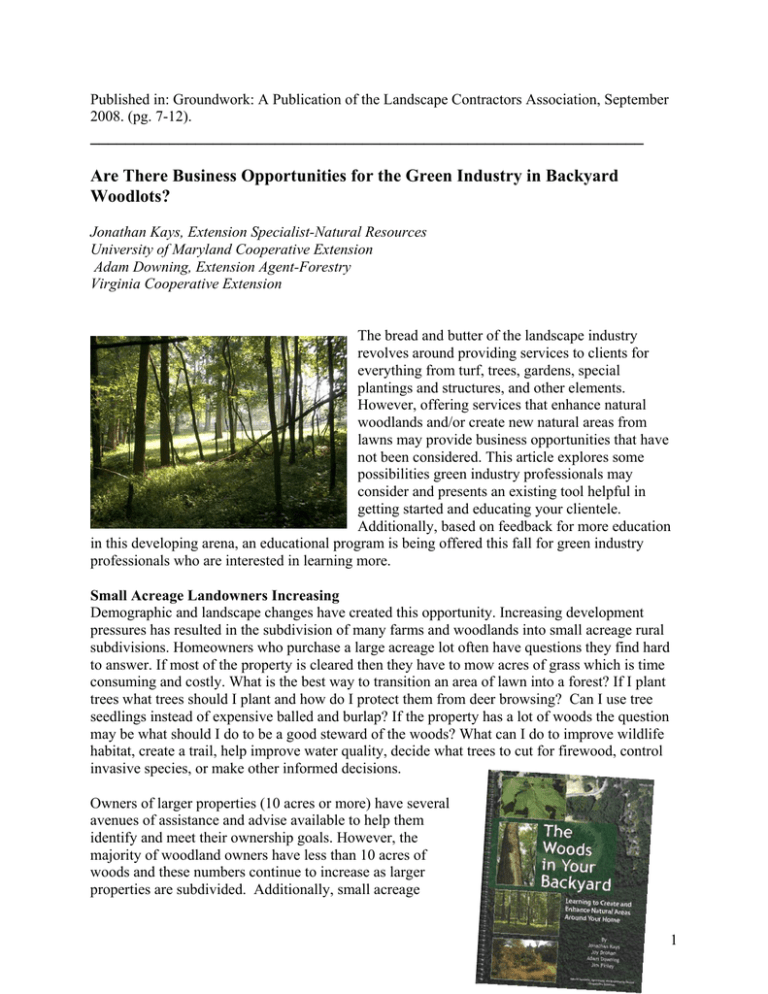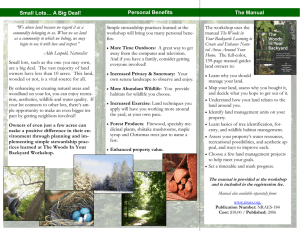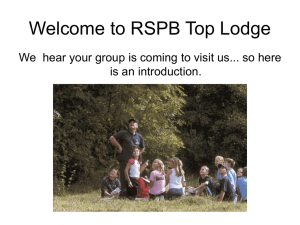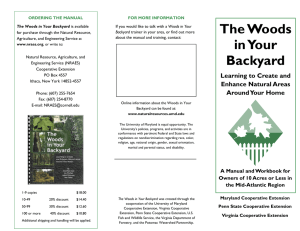Published in: Groundwork: A Publication of the Landscape Contractors Association,... 2008. (pg. 7-12).
advertisement

Published in: Groundwork: A Publication of the Landscape Contractors Association, September 2008. (pg. 7-12). _______________________________________________________________ Are There Business Opportunities for the Green Industry in Backyard Woodlots? Jonathan Kays, Extension Specialist-Natural Resources University of Maryland Cooperative Extension Adam Downing, Extension Agent-Forestry Virginia Cooperative Extension The bread and butter of the landscape industry revolves around providing services to clients for everything from turf, trees, gardens, special plantings and structures, and other elements. However, offering services that enhance natural woodlands and/or create new natural areas from lawns may provide business opportunities that have not been considered. This article explores some possibilities green industry professionals may consider and presents an existing tool helpful in getting started and educating your clientele. Additionally, based on feedback for more education in this developing arena, an educational program is being offered this fall for green industry professionals who are interested in learning more. Small Acreage Landowners Increasing Demographic and landscape changes have created this opportunity. Increasing development pressures has resulted in the subdivision of many farms and woodlands into small acreage rural subdivisions. Homeowners who purchase a large acreage lot often have questions they find hard to answer. If most of the property is cleared then they have to mow acres of grass which is time consuming and costly. What is the best way to transition an area of lawn into a forest? If I plant trees what trees should I plant and how do I protect them from deer browsing? Can I use tree seedlings instead of expensive balled and burlap? If the property has a lot of woods the question may be what should I do to be a good steward of the woods? What can I do to improve wildlife habitat, create a trail, help improve water quality, decide what trees to cut for firewood, control invasive species, or make other informed decisions. Owners of larger properties (10 acres or more) have several avenues of assistance and advise available to help them identify and meet their ownership goals. However, the majority of woodland owners have less than 10 acres of woods and these numbers continue to increase as larger properties are subdivided. Additionally, small acreage 1 landowners can not access the services of commercial forestry professionals who tend to focus on logging and management practices characteristic of larger properties. These facts do not diminish the importance of small acre properties. While the properties may be smaller, each landowner can make a significant impact on that land with more intensive management. A missing piece in many cases is the professional assistance. A logical source of assistance is green industry professionals such as landscapers and arborists who already work in rural subdivisions. However, learning about how to apply forest management practices to small woodlots will require some additional training for most professionals, as well as educational materials that they can provide clients to learn more about options for their own properties. Manual Available To Help Landowners Make Informed Decisions Landowners and service providers can use a newly published manual by the University of Maryland Cooperative Extension to help them make informed decisions that ensure clean water, viable populations of native wildlife, recreational opportunities, and forest health on their property. Entitled The Woods in Your Backyard: Learning to Create and Enhance Natural Areas Around Your Home, this 138-page color, self-assessment manual was specifically developed for owners of 1-10 acres of land with no existing knowledge of forestry or wildlife. While developed primarily for landowner use, it is also useful as a reference and process tool for small acreage service providers. It is appropriate for properties where the owner either wants to turn lawn into forest or just enhance existing natural areas. It suggests that the landowner look at their property as three parts: 1) intensive use areas that included buildings and formal landscaping; 2) intermediate areas such as lawn and pasture; and 3) natural areas such as existing woods or unmowed areas. Are there intermediate areas that can be turned to natural areas by planting trees or letting native growth take over? In the existing natural areas how can I improve wildlife habitat be enhanced or the recreational enjoyment improved? The aerial picture shown here provides an example of two-three acre lots with very different habitat. The lot on the left is heavily wooded from trees that established themselves naturally over a 15 year. Scattered trees around the house were established from tree seedlings. The majority of intermediate area available on the property has already transitioned to natural area and when joined with the neighbor to the left forms an area of 4 acres of woods. The lot on the right only has scattered trees and provides very little in the way of wildlife habitat, privacy, firewood, or nature study, but it has a good open view. The question for this homeowner is: Are there areas of lawn that can be transitioned to natural areas with tree planting, allowing natural vegetation to establish itself, or maintaining an old field area for wildlife by mowing 2 every few years? The manual uses lessons, followed by outdoor investigative activities, to enable the landowner to learn more about their property. A case study is used to help the landowner identify their interests in the land, draw a map, inventory the property, apply ecological principles, and put their knowledge into practice by choosing land management techniques that help them reach their objectives. The manual also provides a primer on how to identify different species of trees and how to deal with invasive species and wildlife damage. Included in the manual is a blank self-guided workbook that enables the landowner to assess their property using the activities and achieve their goals. The appendix provides a categorized resource list and other references for more assistance. By providing the manual to clientele, you help them identify the potential service opportunities which you can then provide. The following pictures provide some examples. Expanding a forested area into a lawn using planted tree seedlings with tree shelters to protect from deer browsing. This maintained trail in a 2-acre backyard woods can provide sanctuary and recreational enjoyment. Trail creation for clients allows them to access their woods. 3 Educating clients that “messy” is good for wildlife is a challenge. The manual can help. Controlling invasive species using herbicides can be effective on smaller properties. Picture by Edwin Remsburg Opportunities for Arborists and Landscapers There are a variety of woodland management activities that can be provided by the green industry such as preparing and planting an existing lawn area with tree seedlings and tree shelters, controlling vines in natural areas, controlling invasive and exotic species, designing and creating trails in natural areas, creating and maintaining tall grass meadows, building brush piles, felling trees for firewood use, felling hazard trees in natural areas, establishing wildlife food plots, cutting trees for income, and growing nontraditional crops such as mushrooms or ginseng. A looming question arises regarding the interest of homeowners to pay for services. Follow-up surveys of Woods in your Backyard workshops in Maryland, Virginia and Pennsylvania verify the positive impacts of workshops for landowners and professionals. A 4 follow-up survey sent to 316 attendees at the 1-2 hour workshops in Maryland (35% response rate) found that over 40% had assessed wildlife habitat, identified their interests, and developed a property map. 23% had contacted a service provider for assistance in implementing a practice and 7% planned to make a contact. Most of these contacts were with green industry professionals. Forty-nine percent had shared the manual and/or information with others and 52% initiated a discussion with friends or family members about creating or enhancing natural areas around the home. Forty-seven percent used the internet to get more information and 18% approached a neighbor and cooperated on activities. High percentages of people had completed woodland management activities on their land and 39% would like more in-depth workshops and training. Only a small percentage of people expressed interest in paying for services at this time but most were unfamiliar with the practices involved. The manual can be provided by green industry professionals to clientele with an interest in natural areas who can then complete a selfassessment of their property and gain understanding and ideas for practices they may wish to undertake. The professional is then dealing with a more educated customer who better understands the value of different practices. A follow-up survey was completed of 50 green industry professionals (arborists and landscapers) who attended a presentation on the Woods In Your Backyard program at one of three professional green industry meetings in fall 2007. Forty-eight percent reported most of their clients had from 1-10 acres of land. Forty-six percent indicated they would be interested in training programs to teach them how to provide a range of woodland management activities listed in the survey. The survey also indicate that arborists were more interested in woodland activities involving tree cutting, firewood selection, and merchandising and landscapers were more interested in tree planting, habitat improvements, invasive species control, recreational trails and other amenity activities. Educational Opportunity Available in November Penn State Cooperative Extension in partnership with the University of Maryland Cooperative Extension and the Penn State School of Forestry is offering a day-long program on November 11 called “Landscapes and Backyard Woodlots: Business Opportunities for the Green Industry.” The goal of this program is to educate green industry professionals about managing backyard forests. There are significant opportunities that this resource provides to expand the traditional business model for landscapers and arborists. This program will provide you, the green industry professional, with the tools and knowledge necessary to serve the expanding market in managing and creating backyard woodlots. PDA and MDA pesticide credits will be awarded to licensed applicators. The program will be held at the Franklin County Extension office in Gettysburg, PA and cost $75 which includes the manual and 11 program topics. For more information call Linda Horst at (717) 263-9226 or access the registration form online at www.naturalresources.umd.edu by clicking on the calendar. 5





